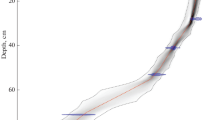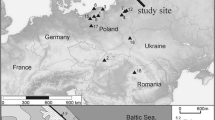Abstract
We investigated the possibilities of reconstructing the hydrological history of an East Carpathian Sphagnum bog (Fenyves-tető, near Erzsébetbánya) based on the Testacea fauna and the humification. A Russian-type sampler was used to supply undisturbed cores of 400 cm in depth. The exotic marker method (Lycopodium clavatum as a marker) was used for quantitative estimation of the abundances. Humic acid concentration was measured by photometry. The age of the peat layers was determined by radiocarbon method. Altogether we identified 33 testate amoebae taxa; there were 10 taxa which were frequent in the samples and have remarkable faunistic and ecological significance. Based on the relative abundance of Testacea taxa, eight zones were identified. The following species were characteristic of dry conditions: Assulina muscorum, Difflugia pulex, and Nebela militaris, while wet conditions were indicated by Amphitrema flavum and Hyalosphenia papilio. We found strong qualitative correlation between the humification and the relative frequencies of the testate amoebae. Major changes of the moisture conditions can be appropriately reconstructed from the quantitative and qualitative analysis of testate amoebae, and offer a good characterization for the rapid changes of the moisture conditions and the stable periods. We have demonstrated that the analysis of Testacea and the study of humification are useful for reconstructing hydrological changes.
Similar content being viewed by others
References
Bahnson, H., 1968. Kolorimetriske bestemmelser af humificeringstal i højmosetørv fra Fuglsø mose på Djursland. Meddelelser fra Dansk Geolologisk Forening 18: 55–63.
Barber K. E., 1981. Peat Stratigraphy and Climatic Change: A Palaeoecological Test of the Theory of Cyclic Peat Bog Regeneration. Balkema, Rotterdam.
Bennett, K. D., 1996. Determination of the number of zones in a biostratigraphical sequence. New Phytologist 132: 155–170.
Carvalho, L. & A. Kirika, 2003. Changes in shallow lake functioning: Response to climate change and nutrient reduction. Hydrobiologia 506–509: 789–796.
Cash, J. & J. Hopkinson, 1909. The British Freshwater Rhizopoda and Heliozoa. Vol. II Rhizopoda part 2. The Ray Society, London: 166 pp.
Charman, D. J., D., Hendon & W. A., Woodland, 2000. The identification of testate amoebae (Protozoa: Rhizopoda) in peats. QRA Technical Guide No. 9, Quaternary Research Association, London: 147 pp.
Corbet, S. A., 1973. An illustrated introduction to the testate rhizopods in Sphagnum, with special reference to the area around Malhalm Tarn, Yorkshire. Field Stud. 3: 801–838.
de Graaf, F., 1956. Studies on Rotatoria and Rhizopoda from the Netherlands. Biologisch Jaarboek Dodonea 23: 145–217.
Ertl, M., 1960. Beiträge zur Kenntnis der moosbewohnenden Thekamöben Ungarns. Opuscula Zoologica Budapest 4: 31–37.
Foissner, W., 1987. Soil protozoa: fundamental problems, ecological significance, adaptations in ciliates and testaceans, bioindicators and a guide to the literature. Progr. Protistol. 2: 69–212.
Heal, O. W., 1961. The distribution of testate amoebae (Rhizopoda: Testacea) in some fens and bogs in northern England. J. Linnean Soc., Zool. 44: 369–382.
Heal, O.W., 1964. Observations on the seasonal and spatial distribution of testacea (Protozoa: Rhizopoda) in Sphagnum. J. Animal Ecol. 33: 395–412.
Hendon, D., 1998. Robustness and precision of Holocene palaeoclimatic records from peatlands using testate amoebae analysis. PhD thesis, University of Plymouth, U.K.
Hendon, D. & D. J. Charman, 1997. The preparation of testate amoebae (Protozoa: Rhizopoda) samples from peat. The Holocene 7: 199–205.
Hendon, D., D. J. Charman & M. Kent, 2001. Palaeohydrological records derived from testate amoebae analysis from peatlands in northern England: within-site variability, between-site comparability and palaeoclimatic implications. The Holocene 11: 127–148.
Hughes, P. D. M., D. Mauquoy, K. E. Barber & P. G. Langdon, 2000. Mire development pathways and palaeoclimatic records from a full Holocene peat archive at Walton Moss, Cumbria, England. The Holocene 10: 465–479.
Korhola, A., 1995. Holocene climatic variations in southern finland reconstructed from peat-initiation data. The Holocene 5: 43–58.
Jowsey, P. C., 1966. An improved peat sampler. New Phytol. 65: 245–248.
Jung, W., 1936. Thekamöben ursprünglicher, lebender deutscher Hochmoore. Abhandlungen Lendesmuseum der Provinz Westfalen Museum für Naturkunde 7: 1–87.
Meisterfeld, R., 1977. Die horizontale und vertikale Verteilung der Testaceen (Rhizopoda, Testacea) in Sphagnum. Arch. Hydrobiol. 79: 319–356.
Schönborn, W., 1962. Zur Ökologie der sphagnikolen, bryokolen un terrikolen Testaceen. Limnologica 1: 231–254.
Schönborn, W., 1963. Die Stratigraphie lebender Testaceen im Sphagnetum der Hochmoore. Limnologica 1: 315–321.
Speranza, A., J. Hanke, B. van Geel & J. Fanta, 2000a. Lateholocene human impact and peat development in the Cerna Hora bog. Krkonose Mountains. The Holocene 10: 575–585.
Speranza, A., J. van der Plicht & B. van Geel, 2000b. Improving the time control of the Subboreal/Subatlantic transition in a Czech peat sequence by 14C wiggle-matching, Quaternary Science Reviews 19 (16): 1589–1604.
Stockmarr, J., 1971. Tablets with spores used in absolute pollen analysis. Pollen et Spores 13: 615–621.
Tolonen, K., 1966. Stratigraphic and rhizopod analyses on an old raised bog, Varrassuo, in Hollola, south Finland. Annales Botanici Fennici 3: 147–166.
Tolonen, K., 1986. Rhizopod analysis. In Berglund, B. E. & J. Wiley (ed.), Handbook of Holocene Palaeoecology and Palaeohydrology. Chichester: 645–666.
Török, J. K., 1993. Study on moss-dwelling testate amoebae. Opuscula Zoologica Budapest 26: 95–104.
van Geel B., J. Buurman & H. T. Waterbolk, 1996. Archaeological and palaeoecological indications of an abrupt climate change in The Netherlands, and evidence for climatological teleconnections around 2650 BP. J. Quaternary Sci. 11: 451–460.
Warner, B. G., 1987. Abundance and diversity of testate amoebae (Rhizopoda, Testacea) in Sphagnum peatlands in southwestern Ontario, Canada. Arch. Protistenk. 133: 173–189.
Warner, B. G., 1990. Testate amoebae (Protozoa). Methods in Quaternary Ecology no. 5. Geosci. Can. 5: 65–74.
Author information
Authors and Affiliations
Rights and permissions
About this article
Cite this article
Schnitchen, C., Magyari, E., Tóthmérész, B. et al. Micropaleontological observations on a Sphagnum bog in East Carpathian region – testate amoebae (Rhizopoda: Testacea) and their potential use for reconstruction of micro- and macroclimatic changes. Hydrobiologia 506, 45–49 (2003). https://doi.org/10.1023/B:HYDR.0000008553.82554.c2
Issue Date:
DOI: https://doi.org/10.1023/B:HYDR.0000008553.82554.c2




